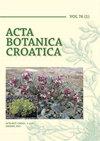冬小麦品种的干旱胁迫反应——叶蛋白和蛋白水解活性的变化
IF 0.7
4区 生物学
Q3 PLANT SCIENCES
引用次数: 11
摘要
辐射诱变作为增加植物变异和提供新选育品系的一种手段,已在可持续农业中得到广泛应用。这就需要利用适当的胁迫标记,将新创造的品系与一些已建立的耐胁迫或易感的品种进行比较。干旱是对植物生产性能和作物产量产生有害影响的最常见的胁迫之一。以M181/1338K突变品系、Guinness耐旱品系和Farmer敏感品系的冬小麦幼苗(3 - 4叶期土壤培养)为材料,进行了严重的干旱胁迫,然后进行了恢复。分析了叶片蛋白谱、Rubisco大亚基(RLS)、Rubisco结合蛋白(RPB)、Rubisco活化酶(RA)、clpA/C等叶绿体特异性蛋白以及外、内蛋白酶活性的变化。在蛋白水平上,M181/1338K和Guinness基因型的RLS和RBP的稳定性、Farmer基因型RLS的降低和RBP的增加对干旱的响应存在差异。在干旱条件下,M181/1338K和Farmer的RA含量下降,而在Guinness恢复期RA含量明显上调。ClpA/C水平在胁迫下均有所升高。在干旱条件下,只有农民的总蛋白水解活性显著增加。抑制分析显示半胱氨酸和丝氨酸蛋白酶类型的优势。恢复后,M181/1338K和Farmer的氨基肽酶活性仍然较高。结果讨论了基因型相关的不同应激应对策略。本文章由计算机程序翻译,如有差异,请以英文原文为准。
Drought stress response in winter wheat varieties – changes in leaf proteins and proteolytic activities
Radiation mutagenesis has been used in sustainable agriculture as a tool
for increasing plant variability and providing new lines for selection.
This necessitates a comparison, by using suitable stress markers, of the newly created lines with some well-established varieties, which are stress tolerant or susceptible. Drought is one of the most frequently encountered stresses with deleterious effects on plant performance and crop yield. Winter wheat seedlings (soil cultures at 3–4th leaf stage) from one mutant line (M181/1338K), one drought-tolerant (Guinness) and one sensitive variety (Farmer) were subjected to severe drought stress by water withholding, followed by recovery. Changes in leaf protein profiles, the amount of Rubisco large subunit (RLS), some specific chloroplast proteins such as Rubisco binding protein (RPB), Rubisco activase (RA), the chaperone subunit clpA/C of clp protease, as well as the activities of exo- and endo-proteases were analyzed. At the protein level, some differences were found in the drought response of genotypes –
stability of RLS and RBP in M181/1338K and Guinness, diminution of RLS and increase in RBP in Farmer. RA presented strong up-regulation at recovery in Guinness but decreased in content under drought in M181/1338K and Farmer. Increase in ClpA/C level was found in all compared varieties under stress. Strong increase in total proteolytic activity was detected under drought only in Farmer. Inhibitory analysis revealed a predominance of cysteine and serine protease types. Aminopeptidase activities remained higher at recovery in M181/1338K and Farmer. Results are discussed in terms of genotype-linked different stress coping strategies.
求助全文
通过发布文献求助,成功后即可免费获取论文全文。
去求助
来源期刊

Acta Botanica Croatica
PLANT SCIENCES-
CiteScore
2.50
自引率
0.00%
发文量
34
审稿时长
>12 weeks
期刊介绍:
The interest of the journal is field (terrestrial and aquatic) and experimental botany (including microorganisms, plant viruses, bacteria, unicellular algae), from subcellular level to ecosystems. The attention of the Journal is aimed to the research of karstic areas of the southern Europe, karstic waters and the Adriatic Sea (Mediterranean).
 求助内容:
求助内容: 应助结果提醒方式:
应助结果提醒方式:


